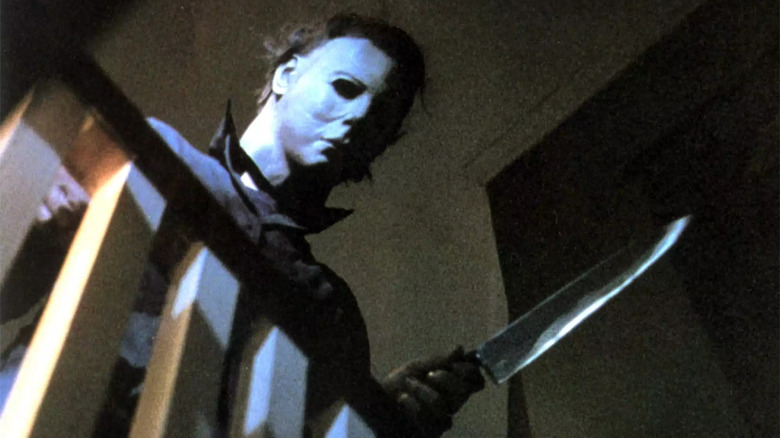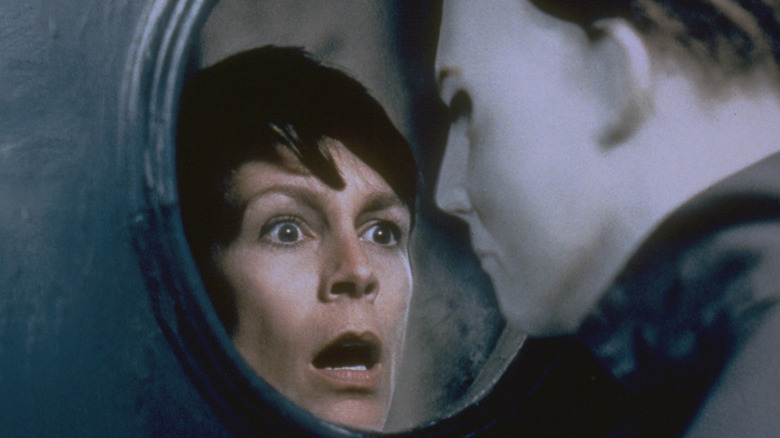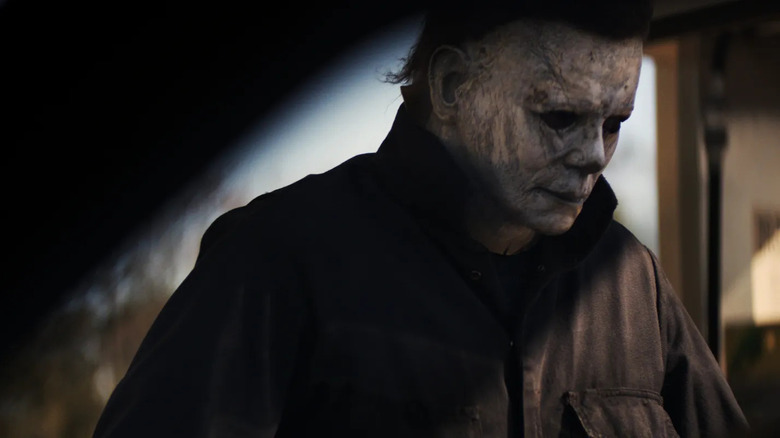The Correct Order To Watch The Halloween Movie Franchise
John Carpenter's 1978 horror film "Halloween" was famously inspired by 1960s serial killer films like Alfred Hitchcock's "Psycho" and Powell/Pressburger's "Peeping Tom," only filtered through a low-budget, '70s grindhouse lens. Initially, "Halloween" was dismissed by audiences, but legend has it that Roger Ebert's overwhelmingly positive 1979 review saved it from obscurity. This may seem like an odd piece of trivia, given that Ebert infamously hated the slasher genre that "Halloween" helped spawn.
For the uninitiated, the original "Halloween" was about an empty-eyed young child, Michael Myers, who killed his big sister in cold blood on Halloween night in 1963. For fifteen years, Michael was kept in an insane asylum where he never spoke a word and stared blankly at a wall. Michael breaks out of the hospital in 1978, travels back to his old neighborhood, dons a creepy white-face mask, and begins stalking and murdering babysitters on Halloween night.
"Halloween" was made for a mere $350,000 and went on to gross $70 million worldwide. That success all but assured at least one sequel. A combination of low budgets, brand recognition, and high earnings have seen "Halloween" sequels released on the regular ever since. To date, there have been 13 "Halloween" movies.
But, confounding to outsiders, those 13 movies actually cover five unique continuities. There is at least one remake (which had its own sequel), and one additional "Halloween" sequel that stands outside all of the other continuities. There are three films in the series merely called "Halloween" and, most frustrating of all, two films called "Halloween II." Certain characters, played by the same actors, are related in some continuities, and not related in others.
This article will reveal the actual release order, and endeavor to lay out, simply, the five separate continuities.
The release order
The actual release order of the "Halloween" movies is easy enough:
- John Carpenter's "Halloween" (1978)
- Rick Rosenthal's "Halloween II" (1981)
- Tommy Lee Wallace's "Halloween III: Season of the Witch" (1982)
- Dwight H. Little's "Halloween 4: The Return of Michael Myers" (1988)
- Dominique Othenin-Girard's "Halloween 5: The Revenge of Michael Myers" (1989)
- Joe Chappelle's "Halloween: The Curse of Michael Myers" (1995)
- Steve Miner's "Halloween H20: 20 Years Later" (1998)
- Rick Rosenthal's "Halloween: Resurrection" (2002)
- Rob Zombie's "Halloween" (2007)
- Rob Zombie's "Halloween II" (2009)
- David Gordon Green's "Halloween" (2018)
- David Gordon Green's "Halloween Kills" (2021)
- David Gordon Green's "Halloween Ends" (2022)
While one can simply sit and watch all the "Halloween" movies chronologically, doing so may keep neophytes off-balance if they weren't present for the constant conversations and publicity surrounding the various rebooted continuities. It's amazing that Carpenter's trim, efficient movie has grown into something so complicated. Luckily, there is a massive legion of long-term gorehounds and horror nuts who have been paying attention the entire time and can easily keep "Halloween" timelines clear in their minds. If they can do it, so can you.
The most important thing to remember is that the central killer is Michael Myers, a semi-supernatural force that is seemingly unkillable and who never speaks. In most versions of the story, Michael has a sister named Laurie Strode (usually Jamie Lee Curtis, but also Scout Taylor-Compton), and his murder spree is sometimes family-related. In at least one movie, there are magic stones and witch cults.
Most important to note: "Halloween III" does not feature Michael Myers at all, but a magical/technological conspiracy to turn children's heads into piles of bugs and snakes.
The split continuity flowchart
Here is a list of the various "Halloween" timelines, handily broken out for the sake of clarity:
Continuity #1:
- John Carpenter's "Halloween" (1978)
- Rick Rosenthal's "Halloween II" (1981)
- Dwight H. Little's "Halloween 4: The Return of Michael Myers" (1988)
- Dominique Othenin-Girard's "Halloween 5: The Revenge of Michael Myers" (1989)
- Joe Chappelle's "Halloween: The Curse of Michael Myers" (1995)
Continuity #2:
- John Carpenter's "Halloween" (1978)
- Rick Rosenthal's "Halloween II" (1981)
- Steve Miner's "Halloween H20: 20 Years Later" (1998)
- Rick Rosenthal's "Halloween: Resurrection" (2002)
Continuity #3:
- Rob Zombie's "Halloween" (2007)
- Rob Zombie's "Halloween II" (2009)
Continuity #4:
- John Carpenter's "Halloween" (1978)
- David Gordon Green's "Halloween" (2018)
- David Gordon Green's "Halloween Kills" (2021)
- David Gordon Green's "Halloween Ends" (2022)
Continuity #5:
- Tommy Lee Wallace's "Halloween III: Season of the Witch" (1982)
Rick Rosenthal's "Halloween II" was the first to mention that Laurie Strode was Michael Myers' sister, and Continuities 2 and 3 play into that relationship rather aggressively. Continuity #1 also mentions that, but Laurie is absent after the first two chapters. Continuity #4 sees the return of Laurie Strode (Curtis), but ignores Rosenthals' "Halloween II," turning Laurie into a new type of character.
None of the continuities, I regret to add, is made up of great movies all the way through. Each one has at least one massive stinker.
"Halloween III" was an attempt to turn the series from a serial killer drama into an anthology series, and was generally rejected by "Halloween" fans for many years. It was eventually critically reassessed and became beloved for how bonkers it is. An evil druid, using a combination of Stonehenge magic and insidious TV signals (!) has cursed thousands of Halloween masks. When kids watch a TV signal while wearing the masks, their heads transform into bugs. Movie magic.


